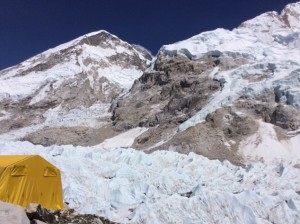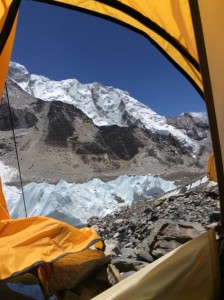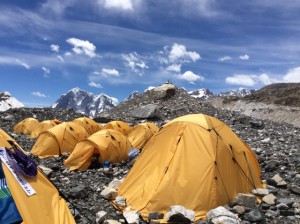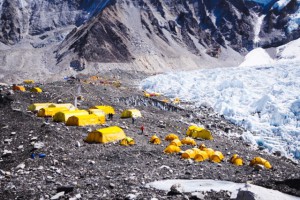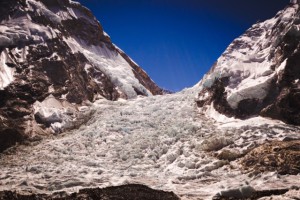Everest Base Camp Part 1
Many of you probably ask themselves very important questions regarding our base camp. And you are right, because what is nothing new to me as an expedition member is of great significance and interest to you. Thus I will now introduce you to Everest base camp in three parts to show you various aspects of life here. This first part covers location of the campsite, its structure as well as dangers and annoyances.
Location
Everest base camp EBC is a term used in general for campsites of expeditions which want to climb Everest. However, one must not understand this term as a single spot where all expeditions jostle. EBC is a rather wide stretch, an area which covers almost the entire Khumbu glacier to the Nuptse west wall. Each expedition picks its own spot. An unofficial pecking order yet seems to determine who resides where. The top-dog, international operators who enjoy a great reputation have the best spots. In other words, those operators which are members of the EOA. This is the Expedition Operators Association.
Now, what means „best spots“? Simply said those with the least risks. Far away from avalanche paths, least shadow, quietness, and things like unlimited access to unpolluted water sources.
All BCs however share one thing: they lie far-flung on the jagged Khumbu glacier at an altitude of 5450 m.
In the foreground of this picture you see the Khumbu glacier. It starts in the Western Cwm, also called Valley of Silence, whose lower region you can spot in the center. This is called the Khumbu icefall. Our EBC lies a 45 minute walk away from the icefall on the glacier opposite the gigantic Nuptse west face. The mountain you see looks a bit like Everest, but is an unclimbed mountain in Tibet. In fact, you can spot Everest with your eagle eyes where the two ridge lines drop to a v-shaped spot in the upper center. There you see Everest with her typical plume. Luckily, from my tent I can not only see her very easily, but also enjoy a breathtaking view on Nuptse and the Khumbu icebergs.
Structure
Our EBC consists of several units that make the camp. These units cover all essentials with one primary goal: to survive at this high altitude. To accomplish this, one needs food, shelter and communications.
All team members enjoy maximum privacy in individual tents. They are rather spacious as they are designed for two people. It is important to have the chance to recline and be with oneself.
It is left to the individual team member how to arrange his tent. However, a certain order is advisable since two kit bags and a lot of gear need to find their spots. I use stuff sacks in the bags which contain my clothes and a checklist indicating the exact content of each sack. This avoids stress to search the kit bags anytime you look for your favourite t-shirt. Personal items like family pictures hang from the ceiling to stay connected with home.
A mess tent serves not only for dining, but also for team members to socialize. It stands next to the kitchen tent. Delicious meals are prepared here by our Sherpa cooks and all dirty plates are washed in a separate scullery just opposite. Next to the scullery is the food store tent which contains all food supplies. Our expedition manager Russell Brice has his own huge tent. It consists of a sleeping facility, has the first aid compartment and all communications. We call it CentCom, Central Command. All Sherpas have their own sleeping and mess tents. Since we have a Discovery Channel film crew with us, they need their separate tent for all technical equipment. Toilet tents are available for both men and women. A shower tent where glacier water is heated with gas provides an essential amenity.
Above picture shows our EBC with all tents as described. A more detailed description of some of the tents will follow in part 2 and 3.
Dangers and Annoyances
We reside on an active glacier which moves about 4 m per year. This means roughly 1 cm per day. And you can feel and hear its movements typically during the night.
The tension, cracking and grating sounds are like someone smashing a sledgehammer against a big rock. A bit scary when you lie in your tent…
The entire area is very prone to rock and ice avalanches. They are a permanent neighbor. The steep faces of Nuptse, Lingtren and Pumori (where the 2015 quake kicked off the devastating avalanche) let tons of ice and rock go both during the day and night. Their roaring power is overwhelming. Usually none of these avalanches roll over the safer spots on the glacier, however there a BC locations which are considered incredibly unsafe. Our BC is at a very safe and elevated spot on the glacier.
The glacier is covered with thousands of rocks of various sizes. That doesn’t mean we walk on paved smooth surface.Where there are no rocks, the sun melts the ice which refreezes during the night. There is an imminent danger of stumbling and slipping which can ruin all your goals.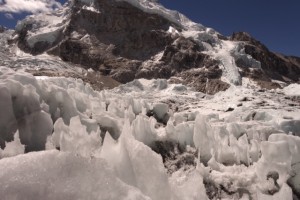
Although being very stable at the moment, the weather can be quite tricky here. As long as the sun shines this place is rather enjoyable. But changes dramatically when the sun sets behind Pumori to something barren and inhospitable. Also sudden changes to strong winds and huge temperature drops can happen in a short period of time.
Access to our EBC for non-team members is strictly by invitation only. Germs and diseases brought in by treckers are too high a danger. They can ruin an entire expedition.
Goraks, large Himalayan crows fly around in EBC. They are true masters of using their beak to break into tents to search for food. Not so cute an animal.
This covers part 1 of my Everest Base Camp series. Part 2 follows soon and deals with food/water, sleeping and energy resources.
Tashi Delek
Andreas
